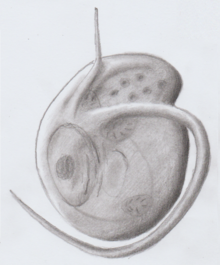Varisulca
| Varisulca | |
|---|---|

| |
| Ancyromonas sp. | |
| Scientific classification | |
| Domain: | Eukaryota |
| Clade: | Opimoda |
| Clade: | Podiata |
| (unranked): | Varisulca Cavalier-Smith, 2002 |
| Classes | |
Varisulca was a proposed basal Podiate taxon.[1] It encompassed several lineages of heterotrophic protists, most notably the ancyromonads (planomonads), collodictyonids (diphylleids), rigifilids (Rigifila, Micronuclearia) and mantamonadids. Recent evidence suggests that the latter three are closely related to each other, forming a clade called CRuMs, but that this is unlikely to be specifically related to ancyromonads.[2]
Cavalier-Smith had proposed the new subphylum Varisulca which consists of the classes Hilomonadea, Diphyllatea and Glissodiscea.[3] The validity of this proposed taxonomy has yet to ruled upon by the Society of Protistologists. It is unlikely to be widely accepted, since Varisulca appears to be paraphyletic or polyphyletic (ancyromonads are not inferred to be the sister group to CRuMs). Glissodiscea and Multirhiza (a taxon encompassing Diphyllatea and Glissodiscea) also appear paraphyletic or polyphyletic, since Mantamonas belongs to CRuMs but ancyromonads do not.
Varisulca appear to be paraphyletic stem Podiata. So the other basal Podiata such as Malawimonas, Metamonada and/or Amoebozoa and Amorphea may have emerged in the Varisulca.[4][5] Some groups of Apusozoa are now considered Varisulca. The Apusomonadida (e.g. Thecamonas) now not directly associated with Varisulca but are considered sister of the opisthokonts. Sulcozoa (originally only Varisulca and Apusozoa)[6] now encompasses the Unikonta/Amorphea and becomes equivalent to (stem) Podiata and Sarcomastigota.[citation needed]
Mantamonadida appear to be sister to Apusomonadida in the Apusozoa in some findings.[7][8]
Taxonomy
[Warning: Varisulca, Multirhiza and Glissodiscea lack molecular phylogenetic support and are strongly non-monophyletic in recent studies]
Subphylum Varisulca Cavalier-Smith 2012
- Superclass Hilomonadia Cavalier-Smith 2012
- Class Hilomonadea Cavalier-Smith 2008 em. 2012
- Order Rigifilida Cavalier-Smith & Yabuki 2012
- Family Rigifilidae Cavalier-Smith & Yabuki 2012
- Genus Rigifila Cavalier-Smith & Yabuki 2012
- Family Micronucleariidae Cavalier-Smith 2008
- Genus Micronuclearia Mikrjukov & Mylnikov 2001
- Family Rigifilidae Cavalier-Smith & Yabuki 2012
- Order Rigifilida Cavalier-Smith & Yabuki 2012
- Class Hilomonadea Cavalier-Smith 2008 em. 2012
- Superclass Multirhiza Cavalier-Smith 2012
- Class Diphyllatea Cavalier-Smith 2003 [Anisomonadea]
- Order Diphylleida Cavalier-Smith 1993 [Collodictyonida]
- Family Sulcomonadidae Cavalier-Smith 2012
- Genus Sulcomonas Brugerolle 2006
- Family Diphylleidae Cavalier-Smith, 1993 [Collodictyonidae Brugerolle et al. 2002]
- Genus Diphylleia Massart 1920 non Michaux 1803
- Genus Collodictyon Carter 1865
- Family Sulcomonadidae Cavalier-Smith 2012
- Order Diphylleida Cavalier-Smith 1993 [Collodictyonida]
- Class Glissodiscea Cavalier-Smith 2012
- Order Discocelida Cavalier-Smith 1997
- Family Discoceliidae Cavalier-Smith 2012
- Genus Discocelia Cavalier-Smith 2013 [Discocelis Vørs 1988 non Ehrenberg 1836]
- Family Discoceliidae Cavalier-Smith 2012
- Order Mantamonadida Cavalier-Smith Glücksman et al. 2011
- Family Mantamonadidae Cavalier-Smith Glücksman et al. 2011
- Genus Mantamonas Cavalier-Smith Glücksman et al. 2011
- Family Mantamonadidae Cavalier-Smith Glücksman et al. 2011
- Order Planomonadida Cavalier-Smith 2008[9] (Ancyromonadida Cavalier-Smith 1998 emend. Atkins 2000)
- Family Ancyromonadidae Cavalier-Smith 1993
- Genus Ancyromonas Kent 1880
- Family Planomonadidae Cavalier-Smith 2008
- Genus Fabomonas Glücksman & Cavalier-Smith 2013
- Genus Planomonas Cavalier-Smith 2008 emend. Cavalier-Smith 2013
- Family Nutomonadidae Cavalier-Smith 2013
- Genus Nutomonas Cavalier-Smith 2013
- Family Ancyromonadidae Cavalier-Smith 1993
- Order Discocelida Cavalier-Smith 1997
- Class Diphyllatea Cavalier-Smith 2003 [Anisomonadea]
References
- ^ Cavalier-Smith, Thomas; Chao, Ema E.; Snell, Elizabeth A.; Berney, Cédric; Fiore-Donno, Anna Maria; Lewis, Rhodri (2014-12-01). "Multigene eukaryote phylogeny reveals the likely protozoan ancestors of opisthokonts (animals, fungi, choanozoans) and Amoebozoa". Molecular Phylogenetics and Evolution. 81: 71–85. doi:10.1016/j.ympev.2014.08.012. PMID 25152275.
- ^ Brown, Matthew W; Heiss, Aaron A; Kamikawa, Ryoma; Inagaki, Yuji; Yabuki, Akinori; Tice, Alexander K; Shiratori, Takashi; Ishida, Ken-Ichiro; Hashimoto, Tetsuo (2018-01-19). "Phylogenomics Places Orphan Protistan Lineages in a Novel Eukaryotic Super-Group". Genome Biology and Evolution. 10 (2): 427–433. doi:10.1093/gbe/evy014. ISSN 1759-6653. PMC 5793813. PMID 29360967.
- ^ Cavalier-Smith T (2013). "Early evolution of eukaryote feeding modes, cell structural diversity, and classification of the protozoan phyla Loukozoa, Sulcozoa, and Choanozoa". Eur J Protistol. 49 (2): 115–78. doi:10.1016/j.ejop.2012.06.001. PMID 23085100.
- ^ Cavalier-Smith, Thomas (2017-02-05). "Origin of animal multicellularity: precursors, causes, consequences—the choanoflagellate/sponge transition, neurogenesis and the Cambrian explosion". Phil. Trans. R. Soc. B. 372 (1713): 20150476. doi:10.1098/rstb.2015.0476. ISSN 0962-8436. PMC 5182410. PMID 27994119.
- ^ Cavalier-Smith, Thomas; Chao, Ema E.; Lewis, Rhodri (2016). "187-gene phylogeny of protozoan phylum Amoebozoa reveals a new class (Cutosea) of deep-branching, ultrastructurally unique, enveloped marine Lobosa and clarifies amoeba evolution". Molecular Phylogenetics and Evolution. 99: 275–296. doi:10.1016/j.ympev.2016.03.023. PMID 27001604.
- ^ Ruggiero, Michael A.; Gordon, Dennis P.; Orrell, Thomas M.; Bailly, Nicolas; Bourgoin, Thierry; Brusca, Richard C.; Cavalier-Smith, Thomas; Guiry, Michael D.; Kirk, Paul M. (2015-04-29). "A Higher Level Classification of All Living Organisms". PLOS ONE. 10 (4): e0119248. Bibcode:2015PLoSO..1019248R. doi:10.1371/journal.pone.0119248. ISSN 1932-6203. PMC 4418965. PMID 25923521.
- ^ Glücksman E, Snell EA, Berney C, Chao EE, Bass D, Cavalier-Smith T (September 2010). "The Novel Marine Gliding Zooflagellate Genus Mantamonas (Mantamonadida ord. n.: Apusozoa)". Protist. 162 (2): 207–221. doi:10.1016/j.protis.2010.06.004. PMID 20884290.
- ^ Orr, Russell J. S.; Zhao, Sen; Klaveness, Dag; Yabuki, Akinori; Ikeda, Keiji; Makoto, Watanabe M.; Shalchian-Tabrizi, Kamran (2017-10-08). "Enigmatic Diphyllatea eukaryotes: Culturing and targeted PacBio RS amplicon sequencing reveals a higher order taxonomic diversity and global distribution". bioRxiv 10.1101/199125.
- ^ Glücksman, Snell & Cavalier-Smith (2013). "Phylogeny and evolution of Planomonadida (Sulcozoa): Eight new species and new genera Fabomonas and Nutomonas". European Journal of Protistology. 49 (2): 179–200. doi:10.1016/j.ejop.2012.08.007. PMID 23369787.
